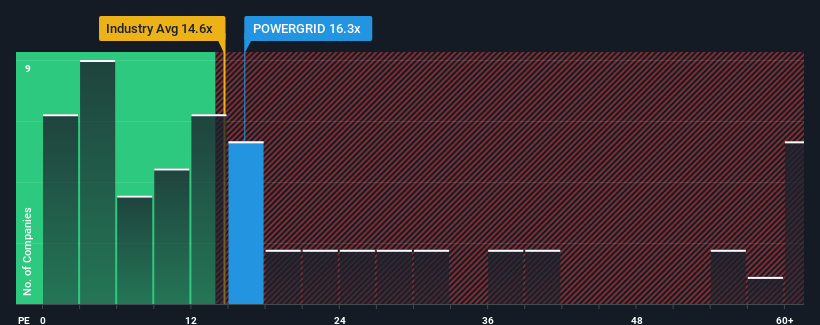Stock Analysis
- India
- /
- Electric Utilities
- /
- NSEI:POWERGRID
Power Grid Corporation of India Limited's (NSE:POWERGRID) Earnings Are Not Doing Enough For Some Investors

When close to half the companies in India have price-to-earnings ratios (or "P/E's") above 32x, you may consider Power Grid Corporation of India Limited (NSE:POWERGRID) as an attractive investment with its 16.3x P/E ratio. However, the P/E might be low for a reason and it requires further investigation to determine if it's justified.
Power Grid Corporation of India could be doing better as it's been growing earnings less than most other companies lately. The P/E is probably low because investors think this lacklustre earnings performance isn't going to get any better. If this is the case, then existing shareholders will probably struggle to get excited about the future direction of the share price.
View our latest analysis for Power Grid Corporation of India

Does Growth Match The Low P/E?
Power Grid Corporation of India's P/E ratio would be typical for a company that's only expected to deliver limited growth, and importantly, perform worse than the market.
Retrospectively, the last year delivered a decent 3.1% gain to the company's bottom line. Pleasingly, EPS has also lifted 33% in aggregate from three years ago, partly thanks to the last 12 months of growth. So we can start by confirming that the company has done a great job of growing earnings over that time.
Turning to the outlook, the next three years should generate growth of 5.0% per year as estimated by the eleven analysts watching the company. Meanwhile, the rest of the market is forecast to expand by 20% per annum, which is noticeably more attractive.
In light of this, it's understandable that Power Grid Corporation of India's P/E sits below the majority of other companies. It seems most investors are expecting to see limited future growth and are only willing to pay a reduced amount for the stock.
The Key Takeaway
It's argued the price-to-earnings ratio is an inferior measure of value within certain industries, but it can be a powerful business sentiment indicator.
As we suspected, our examination of Power Grid Corporation of India's analyst forecasts revealed that its inferior earnings outlook is contributing to its low P/E. Right now shareholders are accepting the low P/E as they concede future earnings probably won't provide any pleasant surprises. It's hard to see the share price rising strongly in the near future under these circumstances.
There are also other vital risk factors to consider before investing and we've discovered 2 warning signs for Power Grid Corporation of India that you should be aware of.
You might be able to find a better investment than Power Grid Corporation of India. If you want a selection of possible candidates, check out this free list of interesting companies that trade on a low P/E (but have proven they can grow earnings).
Valuation is complex, but we're helping make it simple.
Find out whether Power Grid Corporation of India is potentially over or undervalued by checking out our comprehensive analysis, which includes fair value estimates, risks and warnings, dividends, insider transactions and financial health.
View the Free AnalysisHave feedback on this article? Concerned about the content? Get in touch with us directly. Alternatively, email editorial-team (at) simplywallst.com.
This article by Simply Wall St is general in nature. We provide commentary based on historical data and analyst forecasts only using an unbiased methodology and our articles are not intended to be financial advice. It does not constitute a recommendation to buy or sell any stock, and does not take account of your objectives, or your financial situation. We aim to bring you long-term focused analysis driven by fundamental data. Note that our analysis may not factor in the latest price-sensitive company announcements or qualitative material. Simply Wall St has no position in any stocks mentioned.
About NSEI:POWERGRID
Power Grid Corporation of India
Power Grid Corporation of India Limited, an electric power transmission utility, engages in the transmission of power in India.
Established dividend payer with acceptable track record.

